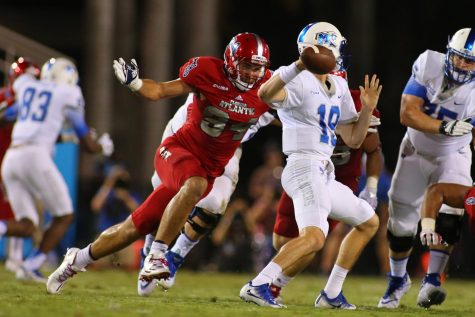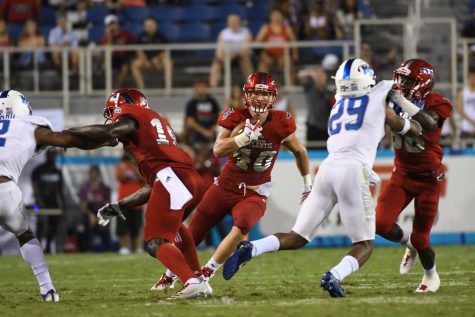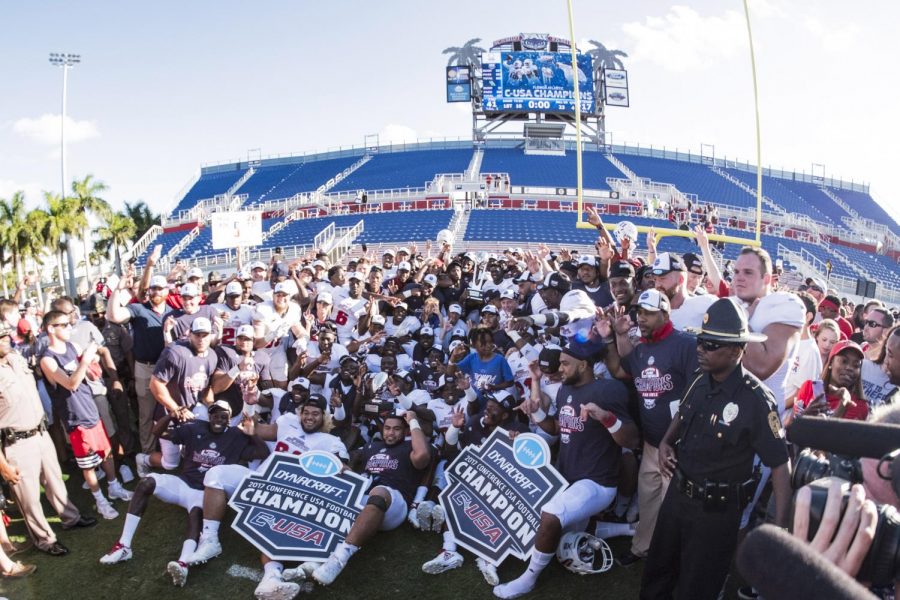Which side of the ball will embody FAU’s team identity this season?
Exploring whether FAU will rely on defensive dominance or an offensive explosion in 2018.
FAU rode a 10-game win streak into its first ever Conference USA championship last season. Photo courtesy of FAU Media Relations
August 20, 2018
I knew on the front end that covering a wildly talented college football team would have its ups and downs.
What I didn’t foresee was that immense wall-to-wall talent making it difficult to pin down a singular team identity.
The Owls have dynamic playmakers and brilliant coaching minds on both sides of the ball. A balanced team is a fan’s dream, but for a writer looking to predict a season’s narrative, it can induce some headaches.
Since it is truly too close to call, I am giving readers a peek inside both units’ strengths to let them decide for themselves.
Will FAU be viewed as a hard-nosed defensive squad or an offensive juggernaut?
The Case for Defensive Dominance
FAU football is shifting its identity to one centered around its ferocious defense.
That defense will take the mantle from the offense as head coach Lane Kiffin’s catalyst for success in 2018.
It all starts upfront for FAU. Last season’s defensive line starters Leighton McCarthy, Hunter Snyder, and Steven Leggett return after helping build one of C-USA’s fiercest pass rushes from a season ago (38 sacks as a team led the conference), but the real strength of their unit is in numbers.
FAU’s defensive line depth was bolstered dramatically with the addition of junior college transfer Charles Cameron and the vast improvements of Ernest Bagner and Tim Bonner.
Cameron enrolled at FAU early, and like the Mississippi native’s January arrival to Boca Raton, his disruptive on-field presence was expedited as well. The junior defensive tackle immediately showed he was a force on the inside, using his quickness to shed blocks and make plays in the backfield throughout spring and early in fall camp.
Bonner and Bagner came from the JUCO ranks a season prior to Cameron, and both made sizable leaps forward following their first season at FAU.
After collecting only two and a half sacks last fall, Bagner used his offseason to improve his craft and become downright unblockable. The senior pass rusher’s efforts didn’t go unnoticed, as his strong play earned him a spring game MVP award.
Versatility became Bonner’s calling card. The 6-foot-5 former “Last Chance U” star flashed a rare ability to slip past blocks from 300-pound offensive tackles on one play and keep up with speedy tight ends and running backs in coverage on the next.
Quarterbacks will be rattled by that multifaceted skill set this season. The hesitation that comes with constantly keeping an eye on whether Bonner is sprinting off the edge, or hovering in the passing lane, will force them into making poor decisions with the football.

FAU’s talented defensive front shows little to no drop off in production between its first and second teams. Having many skilled rushers to rotate in and stay fresh will wear down opposing offensive linemen and give the Owls control of the line of scrimmage late in games this season.
The Owls’ proficiency upfront helps showcase the rest of the defense’s exceptional playmaking ability.
Linebackers Azeez Al-Shaair and Rashad Smith both ranked in the top 12 in tackles for loss among C-USA defenders last season with 11 and 12 respectively, but that figure has a chance to skyrocket in 2018.
FAU’s linebacker duo will be freed up to create havoc behind the line of scrimmage, thanks to the defensive line eating up double team blocks in front of them.
If offensive linemen can’t generate adequate push at the line of scrimmage soon after the play is snapped, they will be late in picking up linebackers like Al-Shaair and Smith. That extra second lost offensively is the difference between a five-yard gain and a five-yard loss.
Al-Shaair was a menace defending the run last season, ranking third in the country with 146 tackles. With his defensive line better than ever, the senior linebacker is in store for an even more dominant campaign in 2018.
With the run game bottled up, opposing offenses will be forced to become one dimensional and pass heavy.
FAU has an answer to that as well.
When an opposing team enters must-pass situations, FAU can dial up pressure through blitzes to bait quarterbacks into making mistakes.
Cornerbacks Chris Tooley and Shelton Lewis will be in prime position to capitalize on those miscues. After nabbing four interceptions each last season (tied for third in the conference), they showed they are more than capable of attacking the ball in the air when it comes their way.
FAU’s ballhawking cornerback tandem has the freedom to aggressively jump passing lanes because star safety Jalen Young is roaming behind providing support.
Young swiped seven interceptions last season, which was tied for second in the nation. The senior’s incredible range in coverage allows his counterparts in the secondary to take more risks in trying to create turnovers.
Coach Lane Kiffin will hand over the reins of his dynamic defense to first-year coordinator Tony Pecoraro, who held the same position at Southern Miss last season.
The Southern Miss defense, led by Pecoraro, was one of the country’s best in 2017. His Golden Eagles ranked No. 20 in the nation in total defense (331.9 yards allowed per game) and tied for No. 16 among 129 FBS teams with 7.4 tackles for loss per game.
With the combination of Pecoraro’s savvy play calling, a deep defensive line, athletic linebackers, and sticky-handed defensive backs, FAU’s defense will assuredly be the strength of its team this season.
The Case for an Offensive Explosion
FAU should consider writing their record books in pencil as long as Kiffin is in town.
Because if last season’s historic statistical output was a hint of things to come, the 2018 Owls offense will be more than just the stronger of two units. It will be the most prolific group this university has ever seen.
In 2017 the Owls jumped their per game scoring output by more than two touchdowns over the previous year, from a middling 26.4 to 40.6. Not only did that average lead the conference, it was good for eighth in the country.
Reigning C-USA MVP Devin “Motor” Singletary was the lifeblood to that offensive resurgence and will be back revving his engine to another stellar season in 2018. The Heisman hopeful is coming off a sophomore campaign where he scored an FBS leading 32 touchdowns, in addition to ranking third in rushing yards (1,920) nationally.
True to his nickname, Singletary is able to hit multiple gears as a ball carrier. Not only can he powerfully pinball off defenders using his rigid 5-foot-9, 200-pound frame, the talented back can also freeze would-be tacklers in the hole with elusiveness and lightning quick jump cuts.
The natural response to defending a running back of Singletary’s calibre would be to load the box and force his team to throw the ball. But as defenses who played against FAU last season learned, that counter is futile against an Owls passing game moving at breakneck speed.
That up-tempo style of play is a perfect fit for receiver Willie Wright, who led his team in receiving scores (6) as a freshman last season. Able to make plays from all over the formation, Wright is a matchup nightmare for opposing defenses that are already scrambling just to get aligned between snaps.
While he may be best known for his abilities as a deep threat, Wright is far from a one-trick pony. The 5-foot-9 speeding bullet can also make people miss after the catch on bubble screens and out race defenders to the edge on reverse handoffs.
Standing nine inches taller with an 85-pound weight advantage, it’s safe to say tight end Harrison Bryant is a slightly different weapon than Wright.
But he is as dangerous on the field.
Able to use his big frame to out jump smaller defensive backs and powerful long strides to burn past slower linebackers, Bryant can get open between the hashes no matter who is guarding him.

Getting open is the first step — what happens after passes are thrown his way truly solidifies Bryant as one of the best players at his position. His hands joined death and taxes on the list of life’s certainties, as the Georgia native led all returning FBS tight ends in receptions (32) without a drop, according to Pro Football Focus.
While the junior’s strong pass catching ability is well documented, Bryant also bolsters the ground game with his willingness and tenacity as a blocker.
As solid as Bryant is in that department, it takes a team effort to build a rushing attack as potent as FAU’s.
That’s where Reggie Bain and Brandon Walton come into play.
FAU’s standout tackle duo returns in 2018, and they headline an Owls offensive line that helped produce 3,994 yards on the ground last season — fourth in the nation. The pair are absolute road graders in the run game, and are also stout in pass protection.
A new signal caller will be lining up behind Bain and Walton in 2018, but if last season proved anything, it’s that change at the quarterback position isn’t always negative.
It took Jason Driskel nearly a quarter of the season to earn the starting job in 2017. He then proceeded to lead C-USA in passing efficiency (149.4) on the year.
While his play was excellent, a lot of his success could be attributed to playing in Kiffin’s quarterback friendly system.
Kiffin has an innate ability to extract the best qualities out of his quarterbacks while hiding any of their possible limitations.
That won’t change any time soon.
Now with a talented trio to choose from in former Florida State Seminole De’Andre Johnson, graduate transfer Rafe Peavey, and former Oklahoma Sooner Chris Robison, the ceiling for Owls quarterback play will be raised even higher this season.
Kiffin managed to transform an afterthought FAU offense into a powerhouse in less than a year.
Now armed with his first full offseason of preparation in Boca Raton, there is no question his high powered Singletary-led unit will be what FAU’s opponents fear most in 2018.
Wajih AlBaroudi is the sports editor of the University Press. For information regarding this or other stories, email walbaroudi1@gmail.com or tweet @WajihAlBaroudi.







